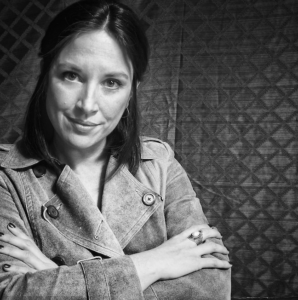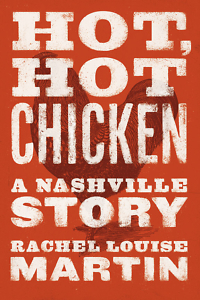Whose Hot Chicken Is It Anyway?
A historian weaves the story of Nashville hot chicken with a chronicle of race and real estate
In the introduction to Hot, Hot Chicken, Rachel Louise Martin marvels that most white Nashvillians of her generation — herself included — grew up knowing nothing about hot chicken, now Nashville’s signature dish and a global phenomenon. She wondered why that was and had a suspicion she knew the answer.
 The question burned its way into Martin’s head and wouldn’t let go. A trained historian and dogged researcher, she responded with a deep dive into the shifting Nashville map — successive waves of Black gatherings and displacements, from Civil War refugee settlements to urban renewal schemes, tornadoes and floods, suburban flight and gentrification.
The question burned its way into Martin’s head and wouldn’t let go. A trained historian and dogged researcher, she responded with a deep dive into the shifting Nashville map — successive waves of Black gatherings and displacements, from Civil War refugee settlements to urban renewal schemes, tornadoes and floods, suburban flight and gentrification.
To Martin, the story of Nashville hot chicken is the story of America itself — of how our race-based caste system has shaped our institutions, our food, and our urban landscapes and the ways those forces have made it so hard for Black entrepreneurs to profit from their own creative endeavors. “Systemic racism meant that hot chicken stayed in a corner of Nashville for almost seventy years before it exploded into the rest of the city,” writes Martin. “When hot chicken left the neighborhood, it did so without taking its progenitors with it.”
A shared love of a fiery soul-food staple might not be enough to heal a city’s centuries-old divisions, Martin admits. But acknowledging its creators and the long odds they faced is an important first step.
Rachel Louise Martin answered questions from Chapter 16 via email.
Chapter 16: One thread of this book is a family history of the Princes, the storied creators of hot chicken. How difficult was it for you to find information about them and to separate the hot chicken legend from reality?
Rachel Louise Martin: History is a powerful element in our society. The story we tell ourselves about our past shapes who we are today and who we will become in the future. As a result, one of the easiest ways to maintain the inequalities that have structured our nation’s past was to control whose stories entered the history books and whose lives were documented in our archives.
In the pre-Civil War era, this meant that many people living in America went literally unrecorded. Enslaved people were not listed by name in the census records. Some of their names are preserved in the memories of their enslaved family members. Others pop up as a passing reference in a white slave owner’s accounts. Most have been forgotten.
Enslaved engineers built our cities. Enslaved cooks enlivened the American diet and nourished generations of bodies. Enslaved artists crafted new forms of expression. Enslaved philosophers and enslaved inventors revolutionized the nation. But too many of their names and their stories have disappeared.
Even after emancipation, Black Americans were omitted from the records the nation created. In May 1940, The Nashville Globe, the local Black-owned newspaper, published a list of 41 Black-owned restaurants in the city. Only 7 of those businesses were included in the city’s directory.
This purposefully spotty record keeping made researching this book much harder. The most important and reliable documents I had were the Nashville city directories. Thornton Prince III, the first proprietor of the business that became Prince’s Hot Chicken Shack, often disappeared even from those, but when I could find his name, I could piece together where he lived and where he worked. From those clues, I could use maps and other clues to reconstruct a bit of his life. But there are giant holes in what I was able to know. Those sorts of holes pockmark all of American history.
 Chapter 16: Another thread of your book is real estate, redlining, and urban renewal. How did a story of hot chicken become a story about shifting philosophies of urban planning?
Chapter 16: Another thread of your book is real estate, redlining, and urban renewal. How did a story of hot chicken become a story about shifting philosophies of urban planning?
Martin: Well, actually, for me the urban planning part came first and the hot chicken story came second.
Around 2007, I read W. Fitzhugh Brundage’s The Southern Past: A Clash of Race and Memory. Brundage describes how in the mid-20th century Black neighborhoods were systematically dismantled through urban renewal and interstate construction. During the same era, white Southerners erected statues, renovated historic landmarks, created museums, carved out battlefield monuments, wrote novels and history books, and transformed the story of history into a useful and useable narrative for their own purposes. Brundage was talking about places like Durham and Savannah, but I knew something similar had happened in Nashville. And I wanted to talk about it.
When I came back to Nashville a few years later and found everyone talking about hot chicken, this food I had never heard of that was apparently our city’s endemic food, I did what any good historian does: I went to the library to investigate. As I dug into the history of hot chicken and the Prince family, I was flabbergasted by the ways the story of the Princes mirrored the major civic and political developments in Nashville. The urban projects forced the Princes to relocate over and over again as “renewal” swept through Black neighborhoods, displacing residents and replacing them with roadways or gentrified neighborhoods.
Chapter 16: Gerald Gimre plays a huge role in this story, although he is not strictly chicken-affiliated. Introduce him for us. Do you think of him as a hero or a villain?
Martin: Gerald Gimre is a hard character for me because I’m afraid I see a bit too much of myself in him. He came to Nashville in the early 1930s as the city’s first zoning and planning engineer, and he developed our first zoning code. When President Franklin Roosevelt commissioned the Works Progress Administration to fund “slum clearance” initiatives, Gimre led the first housing committee, and he became the first director of the Nashville Housing Authority, a post he held until his retirement in June 1970. Most of Nashville’s major urban planning campaigns took place under his direction.
The destruction he caused to the city is obvious. What I hadn’t realized was how well-meaning Gimre was. When he came to Nashville, 13,500 of the 40,000 families living in the city needed entirely new housing. That meant that over a third of the residents were living without access to running water, sewers, or electricity. They lived in overcrowded shacks rented to them by slumlords who refused to maintain the properties. Children and adults died of preventable diseases. The city health officer estimated that folks were losing about a million dollars a year to the town’s rats.
Gimre devoted his career to fixing those problems. But he fixed the problems in the ways he thought best. He did not listen to the people whose lives and neighborhoods he affected. As a result, he literally bulldozed through the middle of the city, decimating neighborhoods and destroying businesses, particularly those belonging to Black Nashvillians.
Gerald Gimre meant well, but you know what paves the road to hell?
The reality is that very few of us are simply heroes or villains. Many of us mean well. Most of us can’t see past our own prerogatives and prejudices. This means the majority of us do more harm than good when we are given access to power.
Chapter 16: Does it trouble you that Prince’s hot chicken became “Nashville hot chicken”?
Martin: This could be a very short answer: yes.
But I imagine you want me to say more than that.
What you’re really asking about is cultural appropriation, a topic that requires more than this space to tackle, but I’ll do my best. Warning, this is still a long answer.
Cultural appropriation is when a dominant culture claims something belonging to a minority culture, erases the people and circumstances that created that item, and then profits from the appropriated piece. Or as activist theoretician bell hooks explains, white Americans too often use ethnicity as a spice “seasoning that can liven up the dull dish that is mainstream white culture.”
So when white eaters tasted hot chicken, many of them wanted to be able to incorporate the dish into their own cooking — that in and of itself was not a problem. Then white eaters wanted to be able to make money off of the dish a Black chef created — that was more of a problem. Then the white cooks and eaters called the dish their own, erasing the Prince family — and that was a huge problem.
One way we’ve done this is by calling the dish “Nashville hot chicken.” This moniker sanitizes and obscures the chicken’s history; it takes the chicken away from the Black family and the Black neighborhoods that produced it; and it lets eaters ignore the way this foodie trend is enriching a number of white restaurateurs. Nashville hot chicken erases the city’s history of segregation, redlining, inequality in education, unjust banking practices, unfair real estate policies, and other forms of prejudice.
These days, every tourist in Nashville hears they should eat hot chicken, but how many of them actually make it to Prince’s Hot Chicken Shack to eat the original? How many even know about Prince’s? The restaurant’s new Broadway location will make it more likely that tourists eat at the family’s restaurant, but it does not change the systemic and cultural issues that kept the Princes (and all other Black restaurateurs) out of the tourist district until 2021.
That leads me to another reason cultural appropriation is hard for white Americans to grasp. White Americans have a habit of taking credit for Black innovation and work. This has been especially true in the culinary world. Thornton Prince III, the founder of the business that is today Prince’s Hot Chicken Shack, had a grandmother who was (probably) an enslaved cook for a wealthy white family one county south of Nashville. When her food wowed the white family’s guests, however, they would not have called the Black chef from her kitchen to praise her. The visitors would have clapped for the white women who had little or nothing to do with the feast. And none of the white family members would have seen anything wrong with that, though I imagine the Black chef must have been livid. I see many parallels when I look at the hot chicken industry in Nashville today.
What can eaters and cooks do about this? Well, the first step is to acknowledge who our food comes from. “Restaurant menus tell me so much about every dish: from where the ingredients come, the hobbies of the animal that I’m eating, and so on,” James Beard-award winning culinary historian Adrian Miller wrote on the blog soulPhoodie. “If a chef can locally-source ingredients, can’t he or she ‘culturally source’ their food as well?”
I’ll take that one step further. Eaters shouldn’t rely only on chefs to supply that information. If you want to be a responsible foodie, do your own research.
As eaters, we also need to become intentional about where we spend our dollars. For white customers, that means examining the assumptions we make about businesses placed in Black neighborhoods and being intentional about visiting Black-owned establishments. White eaters need to challenge the coded ways diners and reviewers talk about Black-owned businesses.
And we all need to learn how to shut up and listen. What do our neighbors say they want? What do they say they need? What obstacles make it harder for them to achieve their goals? How do they want us to join them in their fight?
Chapter 16: In the conclusion you ask, “Is there a way for us to finally build a city where every resident has an equal chance to thrive?” After all this research, what’s your take on this question?
Martin: I have to believe so, but creating that future will take more work and more discomfort than most of us — especially most of us white Nashvillians — have been willing to do so far.
For far too many years, desegregation/integration has meant “allowing” people of color into previously all-white spaces. As local lawyer and civil rights leader Avon N. Williams told The Tennessean in 1966, “We have the white liberal who is willing to let the Negro advance as far as he can. But this is no longer enough. Now, it is no longer enough.”
Changing our spending habits is especially important moving forward. In 2019, only 7 percent of small businesses in the United States were Black-owned. Then COVID-19 hit. Within the first few weeks of the pandemic, 41 percent of Black-owned business permanently closed as did 32 percent of Latinx-owned businesses and 26 percent of Asian-owned businesses. That’s compared with only 17 percent of white-owned businesses.
If you live here in Nashville, some of my favorite ways to find Black-owned businesses are to look at listings on RankTribe, consult a crowd-sourced listing of local Black-owned small businesses, and check the Black Business Nashville Facebook page for new business announcements.
As voters, we have to demand that municipal, state, and federal regulations don’t just create some sort of false equality starting today. We need policies that undermine the centuries of laws that prevented non-white Americans from accumulating the generational wealth, education, and respect accorded to their white neighbors. Yes, I am talking about reparations. But we also need to discuss how loan officers and investment bankers make their decisions. An audit by the Federal Reserve in 2017 found that bankers approved only about 47 percent of loans to black-owned businesses and 61 percent to Hispanic-owned businesses but about 75 percent of loans to white-owned businesses.
Redlining and banking inequality and other forms of structural racism aren’t our past; they are our present. It’s time for us — all of us, even those of us who have profited from this inequality — to demand change.
[Read an excerpt from Hot, Hot Chicken here.]

Kim Green is a Nashville writer and public radio producer, a licensed pilot and flight instructor, and the editor of PursuitMag, a magazine for private investigators.





